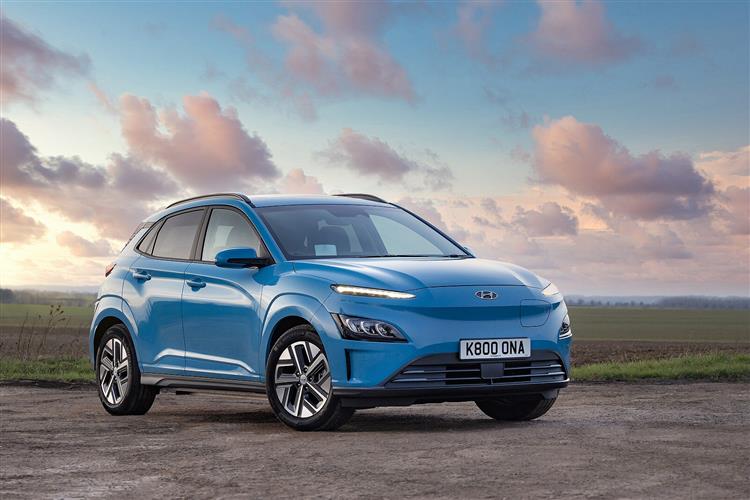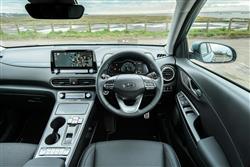MORE ELECTRIC DREAMS (some text hidden) --NONE--
By Jonathan Crouch
Introductionword count: 62
Hyundai's first generation Kona Electric played a significant role in the expansion of the EV market following its introduction in 2018, hence the importance of this updated version of the MK1 model in 2021. Cabin quality and connectivity took a big step forward. And with the top version, driving range was still class leading. Plenty to like as a used buy then.
Modelsword count: 7
5dr SUV (EV) [SE, Premium, Premium SE]
Historyword count: 333
No manufacturer is more invested in the whole concept of clean automotive mobility than Hyundai. By the century's second decade, the brand had mild hybrid, full-hybrid and even hydrogen fuel cell options in its range. And of course, some full-electric battery-powered EV models too. Here's perhaps the most familiar of them, the Kona Electric, first launched in 2018, then significantly updated two years on to create the car we're going to look at here. When the automotive history books come to be written on the period in which EV motoring got underway, the Nissan Renault Alliance group might well get plaudits for introducing the first mass market models (the Nissan LEAF and the Renault ZOE). But it's arguably the Hyundai Motor Group who should get the credit for really popularising the segment with the launch of two models in 2018, the Kia e-Niro and the original version of this Kona Electric. Back then, it was pretty unusual for a car of this size to be available in a variant that gave you up to 300 miles between charges - come to think of it, it's still pretty unusual. But of course, following this car's market introduction, other brand piled into this segment, that for more affordable family hatch-sized EVs, some of them family hatches, some of them superminis and some, like this car, with a leaning toward the Crossover genre. In 2021, Nissan's LEAF was still a major player in this part of the market but by then, increasingly, so were German-engineered contenders like the Volkswagen ID.3 and the Skoda Enyaq iV. Mind you, the Kona Electric featured quite a bit of German engineering too and looked significantly more class-competitive following the wide-ranging package of updates that created the car we're going to look at here, embellished with smarter looks and a rejuvenated cabin full of digital connectivity. The MK1 updated Kona Electric sold in its this form between 2021 and Summer 2023, when it was replaced by a new second generation model.
What You Getword count: 520
This improved MK1 Kona Electric emerged from this mid-term update looking a little smarter and more gym-toned than before, though, as so often with mid-term updates, you might initially be scratching your head a little to establish exactly why. Possibly it's because in this form it was a little more obviously an EV - the kind of thing the market these days seems to clearly want. Come in search of the changes made here over the 2018 original version of this model and most are to be found up-front. With this revised design, there's no pretence at a grille (previously there was a perforated front panel). Hyundai now wanted you to know without any question that this was an EV, hence the rather curious decision to try and make a frontward feature out of the charging port flap. More successful were the changes made to the upper LED daytime running lights and the sleeker headlamp pods, the beams embellished with multifaceted reflector technology. From the side, the look remained much as it was before, though if you were to get your tape measure out, you'd find this updated design to be 25mm longer than its predecessor: It's actually not that much different behind the wheel from the original model - but it feels as if it is because the screen technology took such a step with the adoption of big 10.25-inch displays across the range for the instrument cluster and the centre screen, which in this updated model came complete with a whole range of 'Bluelink' connectivity functions. The cabin differences over an ordinary combustion Kona are actually more pronounced than you might expect, the key change being the installation of a wider aircraft-style silver-trimmed centre console, which incorporates the 'shift-by-wire' push-button controls for the single-speed auto gearbox that all EV models have to have. As before, you're not sat particularly commandingly in what is supposed to be an SUV, but up-front you're favoured with a pair of unexpectedly cushy pews that should allow all shapes and sizes to get comfortable. And, unique to this Electric model is the extra storage space you get under the broad centre console. And in the rear? Well it's in this part of the car that you're likely to be most keenly reminded that you've bought an SUV based on a small car platform, rather than that of a family hatchback. As it turns out, it's not too bad in the back for the carriage of two folk, providing they're not especially lanky of leg. If they are, then compromises will be need to made by the front seat occupants in order to be able to accommodate them. Let's finish with a few words on boot space. The design team's efforts to build in the battery packs in a way that doesn't impinge on carriage capacity weren't entirely successful. That fell from the 374-litre total you get in a standard Kona to 332-litres here. Push forward the 60/40 split-folding rear seat and you'll reveal a relatively flat loading floor with as much as 1,114-litres of total fresh air if you load to the roof.
To see the full road test text contact us on 0330 0020 227
Pictures (high res disabled)

.jpg)
|
.jpg)
|
.jpg)
| |||
.jpg)
|

|
Scoring (subset of scores)
Category: Hybrid, Plug-in, Electric & Hydrogen
| Performance | |
| Handling | |
| Comfort | |
| Space | |
| Styling, Build, Value, Equipment, Depreciation, Handling, Insurance and Total scores are available with our full data feed. | |



